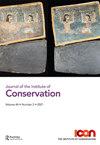离开滑雪道:三个平版滑雪海报的处理案例研究
IF 1
0 HUMANITIES, MULTIDISCIPLINARY
引用次数: 0
摘要
摘要本文介绍了一个案例研究的三个平版滑雪海报,c.1940,保存在一个独立的保护工作室为一个商业客户。每张海报(确定为海报A, B和C),虽然媒体相似,但条件不同,提出了不同的挑战,需要量身定制的治疗方法。海报A在其二级支撑中含有高度易失性的蓝色染料,这给去除衬底带来了挑战,这是通过使用连续水流的浴缸浸泡而实现的。海报B有大面积的损失,通过使用另一个版本的海报的数字印刷传真重新整合。海报C有一个泡沫核心二级支撑,用合成粘合剂粘在一起,用海报反面的薄层去除。治疗的细节,以及伦理考虑和结果,被检查和讨论。本文章由计算机程序翻译,如有差异,请以英文原文为准。
Going off-piste: a case study of the treatment of three lithographic ski posters
Abstract This article presents a case study of three lithographic ski posters, c.1940, conserved at an independent conservation studio for a commercial client. Each poster (identified as Posters A, B and C), although similar in media, varied in condition and presented different challenges which required tailored approaches for treatment. Poster A contained a highly fugitive blue dye in its secondary support, presenting challenges for backing removal, which was made possible through the use of an immersion in a bath with a continuous flow of water in and out. Poster B had a large area of loss that was reintegrated through the use of a digitally printed facsimile from another version of the poster. Poster C had a foam core secondary support adhered with a synthetic adhesive that was removed with a thin layer of the verso of the poster. Details of the treatments, along with ethical considerations and results, are examined and discussed.
求助全文
通过发布文献求助,成功后即可免费获取论文全文。
去求助
来源期刊

Journal of the Institute of Conservation
HUMANITIES, MULTIDISCIPLINARY-
CiteScore
1.50
自引率
0.00%
发文量
22
期刊介绍:
The Journal of the Institute of Conservation is the peer reviewed publication of the Institute of Conservation (Icon). As such, its aims reflect those of Icon, to advance knowledge and education in conservation and achieve the long term preservation and conservation of moveable and immoveable cultural heritage. The Journal provides a collective identity for conservators; it promotes and supports both the profession and professionalism. With international contributions on all aspects of conservation, it is an invaluable resource for the heritage sector. The specific aims of the Journal are to: 1. promote research, knowledge and understanding of cultural heritage conservation through its history, practice and theory 2. provide an international forum to enable and disseminate advances in research, knowledge and understanding relating to conservation and heritage 3. champion and support professional standards of heritage conservation in the UK and internationally 4. provide a permanent record of issues relating to conservation and heritage 5. be financially and operationally sustainable. To achieve these aims, the Journal invites contributions from all those involved in the conservation of cultural heritage and related activities. Areas of interest include understanding cultural heritage materials and their degradation; subject reviews and histories of cultural heritage materials and conservation treatments; new, innovative or improved approaches to conservation and collections care theory, practice, communication, management and training; case studies demonstrating new, innovative or improved approaches; and conservation in its wider context. Submitters are encouraged to demonstrate how their work is of practical application to conservation. To maintain professional standards and promote academic rigour, submissions of articles and shorter notices are subject to an anonymous peer review process.
 求助内容:
求助内容: 应助结果提醒方式:
应助结果提醒方式:


